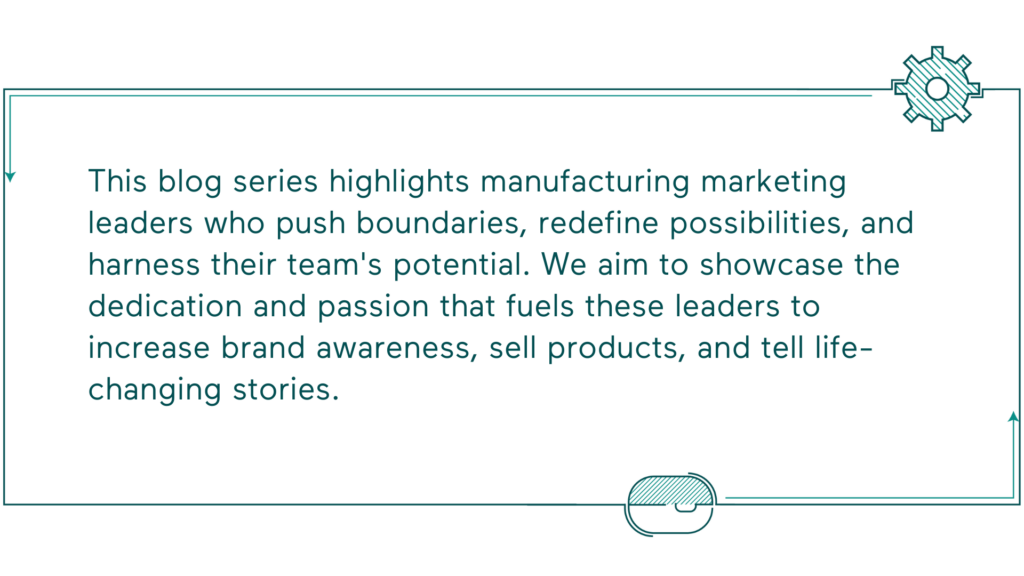
“I would say manufacturing chose me; I didn’t choose it.”
Hexcel Corporation’s Vice President of Global Corporate and Marketing Communications, Chuck Cadena, shared that sentiment while reflecting on a career that has taken him from working in the seat of government on Capitol Hill to the lush green and mountainous landscapes of the Pacific Northwest to the Air Capital of the World (i.e., Wichita, Kan.) and most recently, back to the East Coast.
Chuck has always embraced new opportunities to learn, explore, and adapt wherever he finds them. He has always seen himself a bit of an explorer that way. Where others might see moving across the country multiple times to chase a career as disruptive, Chuck sees opportunities for growth. His willingness to embrace change has been a defining characteristic throughout his career and has led him to where he is today.
But to truly understand who Chuck is and what drives him, you have to start from the beginning.
A passion ignited: The pursuit of impactful, historical brands
Since his early childhood, Chuck has had a passion for history and current affairs. Maybe it was the influence of the 1980s’ omnipresent news headlines and pop culture. MTV was killing off radio stars and NASA first launched the Space Shuttle. CNN was pioneering the world’s first 24-hour news coverage and Ford, GM, and Chrysler were embattled in an existential competition with automotive manufacturers from Japan and Germany.
Chuck entered the University of New Mexico pursuing a major in chemistry, but he quickly discovered an aptitude for social sciences. Earning a degree in history and political science would put him on a path toward some of his greatest adventures. Upon graduation, he packed up his things in search of the nearest open road heading east. Destination: Washington D.C. He would eventually work for several members of the U.S. Congress as a legislative staffer.
He remembers long days and humid summers in the nation’s capital, but he loved every minute he spent there. He loved walking the halls, visiting the monuments, and experiencing the splendor of where so much U.S. history was made. While in D.C., Chuck was also introduced to one of the foundations of U.S. politics: building strong relationships. It’s a lesson he leans on in his work and every facet of his life.
“Relationships are really how things get done,” he says. “As a leader, you eventually move away from being a day-to-day practitioner. It becomes less about how you write a campaign or edit copy or deliver a press release, and more about working across an organization.”
Chuck zigged when he moved from New Mexico to Washington D.C., and he zagged again when he moved across the country to Seattle, where he began his career in aerospace working for The Boeing Company. He was immediately awestruck by the magnitude of its manufacturing operations.
“Most people never see manufacturing at that level. It is truly breathtaking,” he says. “When I see the sheer scale of aerospace manufacturing, and I walk through those factories, it’s like when I would walk by the Supreme Court or the U.S. Capitol,” he says. “You never get tired of the feeling it gives you. The grandeur of it and the history. There’s nothing like walking by a large aircraft being built.”
After twelve years in Seattle, Chuck’s career with Boeing took him back to Washington D.C. and St. Louis. Following his time with Boeing, Chuck eventually moved to Wichita to lead communications, marketing, and government relations at Spirit AeroSystems, a role he held for six years. Most recently, he returned to the East Coast to lead corporate communications and marketing communications for Hexcel, a global leader in advanced composites technology.
His appreciation for the industry has only deepened over time. His shift from government to aerospace illustrates perfectly how diverse experiences can converge to create a fulfilling and impactful career journey.
Mission accomplished: A successful & strategic team effort
At Spirit, Chuck took great pride in his team’s accomplishments. One of the most impactful projects was repositioning the Spirit brand to focus on customer needs instead of just the cutting-edge products it produced. Both types of messaging are important, but the former acknowledges the customer as the hero and shows a company’s ability to understand them and willingness to meet their needs.
The pinnacle of the rebranding project was rewriting Spirit’s mission statement: Move people, communities, and the world forward as the vital partner for inventing, designing, and building what’s best in aerospace.
Writing a mission statement is about crafting a single sentence, but the role it played for Spirit was bigger and more profound—the process realigned the company’s identity with its stakeholders. For Chuck and his team, the project became a unifying force, capturing the emotional essence of the company’s journey and connecting with employees, partners, and the community on a deeper level. The process provided clarity around the company’s values, but it also helped inspire stakeholders and make them feel like active participants in shaping the future of the organization.
“The mission statement work started with the goal of improving employee engagement, but we quickly realized how it transcended the original intent of the project and became about how we connected the organization in an inspiring way with all of our audiences,” Chuck says. “If you looked at the website and other materials, the theme of moving you, moving the world, was infused into everything. It was the cornerstone of our marketing and branding narrative.”
An unexpected benefit of the mission statement work was that it infused talent acquisition marketing. Chuck explains that the “what moves you” messaging in the statement itself was about airplanes literally moving people, but also an emotional connection designed to inspire potential employees to join a company they believe in.
Leadership: Collective success, not individual accolades
Chuck is quick to point out that he didn’t write the mission statement; he wasn’t the wordsmith carefully choosing each noun and verb. Instead, his role was bringing the team together, orchestrating the process, gaining buy-in with the executive team, and helping remove barriers. One of the things he’s proudest of during the project is the role his team played in shaping the strategic direction of the company.
That approach is indicative of Chuck’s brand of leadership. He rejects complex leadership frameworks, instead relying on trust and granting autonomy freely. He doesn’t look over his team’s shoulders; instead, he encourages them to explore options and make smart decisions while focusing on outcomes. His goal is to ensure they can lead and innovate, regardless of who holds the highest title.
“I’ve always been fortunate to build teams full of great leaders, and they took us to a lot of places that were new and forward-thinking,” he explains. “They knew what they needed to achieve, they understood the business objectives, and they came up with wonderful ideas.”
His leadership style depends on building a team of the right people in the right seats; it prioritizes group success over individual accolades.
“As much as my team needed input from leaders across the business, leaders needed input from the communications and marketing team on strategic decisions because we bring a certain perspective and knowledge, as well,” Chuck says. “To achieve your goals, you have to be part of a team that has a seat at the table and works with leadership to shape business objectives. There’s a difference between a team that receives direction and goes off and does its work versus one that helps shape the company’s strategic direction with the work it does everyday.”
What people don’t realize about manufacturing
Chuck wishes more people understood the “coolness” of manufacturing and better appreciated the complexity involved in its operations. He feels that the field is often underappreciated for its advanced technology and the awe-inspiring products it creates and that people use every day.
One of the most memorable and enjoyable projects in Chuck’s career was building a communications strategy for the 777-200LR Worldliner. Launched in the early 2000s, the long-range aircraft was designed to connect any two city pairs around the world nonstop, a ground-breaking innovation at the time. The campaign spanned a year and involved showcasing the aircraft at airshows and cities worldwide, culminating in a world record-setting flight to demonstrate its long-range capabilities.
Technical capabilities aside, what made the 777 project so special for Chuck was the teamwork involved. “It was such a well-functioning, cross-functional team with communications, marketing, and program leadership—all of it came together wonderfully,” Chuck reflects. “It was truly working together at its finest.” The collaborative environment and the seamless integration of various functions made this project a thrilling and rewarding experience.
He also feels that manufacturing as an industry provides countless opportunities for people to build long-term careers inside and outside the factory—a fact that is often overlooked.
“These are the headwinds we fight,” Chuck laments. “Everyone is told to go to college versus getting a few years of technical vocational training and getting into a very well-paying job in manufacturing. Many companies will even send you to college and pay for it. Then you graduate without any debt, and you’re already on a career path. Manufacturing is vitally important for our economic well-being and national security.”
Just as Chuck wishes more people understood the coolness of manufacturing, he wishes people understood and appreciated the complexities inherent in the field. This posed a challenge for the industry when a door plug detached from a 737 aircraft, an Alaskan Airlines flight, in early 2024. The event brought an unprecedented focus by the media on airplane manufacturing, highlighting production practices that people outside of aerospace know very little about. This created a significant communications challenge to keep pace with and get in front of media coverage of such a complex topic.
Chuck emphasizes the need for marketers in highly regulated manufacturing industries like aerospace to think through each and every stakeholder who comes into contact with their product throughout its lifecycle, not just their buyers. For aerospace, that means creating messaging and content tailored to every audience that encounters the aircraft, from employees, the flying public, regulatory authorities, government leaders, investors and the media.
“Mainstream media and the general public don’t fully appreciate the complexity of everything that goes into building the airplanes we travel in every day because it’s a side of the industry they don’t encounter until something goes wrong,” Chuck says. “This can be a challenge even with the regulators of the industry and policymakers who tend to focus on oversight issues and legislative policy. You have to be ready with various levels of messaging that simplify and demystify the volume of complex manufacturing to create mutual understanding and dispel misconceptions with key audiences.”
What the future holds
It’s time to reintroduce people to modern manufacturing, Chuck says. Today’s manufacturing is advanced and technical, requiring an eye for detail and an understanding of cutting-edge technology. Future manufacturing will be even more advanced, creating new opportunities in the industry that do not exist today.
For Chuck, the appeal of working in aerospace manufacturing is the dynamic nature of the industry as it looks to develop next-generation commercial aircraft that are more efficient, capable and sustainable. The emergence of new commercial space companies, eVTOL aircraft, and efforts to take humans to the moon and eventually to Mars excites him every day. What’s more, he recognizes that he gets to work with great people.
As a member of the team, he brings diverse experiences and a willingness to go where needed. As a leader, he loves helping smart people achieve their potential. “I didn’t get to where I am today on my own,” he says. “A lot of people took chances on me. I try to do the same thing for people I work with.”
Reflecting on his career, Chuck is humbled. “I look at my career and I’m grateful for all the opportunities I’ve had and all the people who helped me along the way. I hope there are people who feel similar about me. I’m just grateful that this industry found me and that I’ve been able to be a part of it for as long as I have.”




